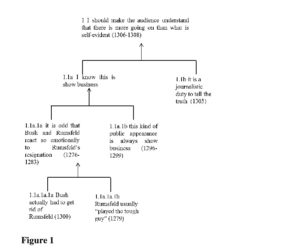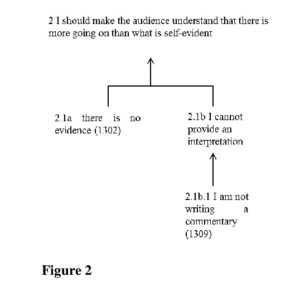ISSA Proceedings 2014 ~ Arguing With Oneself In Writing For The News
No comments yetAbstract: This paper addresses intrapersonal argumentation in the soliloquy occurring within oneself while making decisions. It focuses on the analysis of an example of soliloquy by a journalist arguing about his choices in newswriting, made observable by means of a cue-based Retrospective Verbal Protocol from Progression Analysis. After having reconstructed the argumentation structure of the soliloquy in pragma-dialectical terms, the Argumentum Model of Topics is applied to explain the inferential relation between standpoints and arguments.
Keywords: argumentative soliloquy, Argumentum Model of Topics, intrapersonal argumentation, newsmaking, progression analysis.
1. Introduction
If inner dialogue is not a form of argumentation, what is it then? Should we think of two completely idiosyncratic phenomena, we would paradoxically maintain that, in a public argumentative discussion, standpoints are defended reasonably; yet that they originate uncritically in the black box of the arguers’ minds. So one would be bound to publicly defend in a reasonable fashion what he has unreasonably decided in his silent thoughts.
(Greco Morasso 2013, p. 60)
From this provocative quote from Greco Morasso’s (2013) account of argumentative inner dialogue in migrant mothers,[i] I shall start my reflection upon the much-debated issue of arguing with oneself. Although this topic has received a lot of attention from psychology and sociology (e.g. Billig, 1996 [1987]), as well as from philosophy (Perelman & Olbrechts-Tyteca 2010 [1958] mention Isocrates, Pascal, Schopenhauer and Mill, but Plato dealt with it too), argumentation theory devoted only marginal interest to it. In fact, the main focus of the latter has always been dialogue. Nevertheless, some scholars (amongst others Dascal, 2005; Greco Morasso, 2013; Perrin & Zampa, under review; Rigotti, 2005; Rocci, 2005) turned to intrapersonal argumentation. Therefore I set the present contribution in a still less explored branch of argumentation studies. More precisely, I consider “self-directed argumentation” (Rigotti, 2005, p. 94) enacted within oneself while making decisions in what I call the argumentative soliloquy. I assume the soliloquy to be comparable to a critical discussion, whose protagonist and antagonist are one and the same person.
But how can such a claim be proven? How can a soliloquy be captured? A precise, flawless recording of inner speech is still not feasible today, as it would require installing some science-fiction device in the thinker’s brain. Anyway, data that get close to it are at disposal: cue-based Retrospective Verbal Protocols (from now on, RVP) from Progression Analysis (Perrin, 2003, 2013). RVPs are verbalizations of decision-making during writing, made by the author while watching video recordings of the writing process he just completed. I here take as an example an RVP produced in a television newsroom, i.e., a journalist’s reflections about the coming into being of the textual part of a television news item. The data analysis (Section 4) is conducted on two levels: first I reconstruct the argumentation structure of the soliloquy following Pragma-Dialectics (van Eemeren & Grootendorst, 2004), then the inferential relation between selected standpoints and arguments by means of the Argumentum Model of Topics (Rigotti 2006; Rigotti & Greco Morasso, 2009, 2010, in preparation – from now on, AMT). Before moving to the analysis, I provide a brief account of the state of the art of the studies on argumentation in inner speech I base my analysis upon (Section 2) and introduce the corpus and research method I work with (Section 3).
2. On intrapersonal argumentation[ii]
The data I analyze in this paper (see Section 3) comes as close as possible to reproducing a soliloquy in the sense of the process of “speaking to oneself” (Rigotti, 2005, p. 94). The soliloquy is all the more relevant to argumentative analysis because “[it] appears as the human activity in which – so to speak – one works for persuading oneself” (2005, p. 114). In other words, in a soliloquy the same person plays the role of protagonist and antagonist in turn, and the result is rational persuasion.
The similarities between intra- and intersubjective argumentation are particularly relevant to the present analysis, as they make it possible to analyze soliloquies with the same tools used for dialogues. Perelman and Olbrechts-Tyteca (2010 [1958]) address such similarity by describing argumentation with oneself as “self-deliberation”:
when a person is thinking, his mind would […] strive to assemble all arguments that seem to it to have some value, without suppressing any, and then, after weighing the pros and cons, would decide on what, to the best of its knowledge and belief, appears to be the most satisfactory solution.
(Perelman and Olbrechts-Tyteca, 2010, p. 40)
In self-deliberation one does not follow any shortcut, but argues for and against standpoints exactly as he would do in deliberating with other people. Dascal (2005) focuses on this link too. He assumes that between external debates and mental activities there are metonymic relations: they both belong to “the social activity ‘debate’” and the “mental moves that take place in foro interno […] are entirely subservient to what is currently going on in foro externo.” (ibid., p. 44). At the same time, they are in a metaphorical relation, for some features of the source domain “external debate” are projected onto the target domain “internal debate”. Both are a form of deliberation in the Aristotelian sense of “the mental process through which an individual establishes his preferences and decides how to act”, aiming at leading “to rational persuasion in favour of one of the options” (ibid., p. 52). Finally, Greco Morasso (2013) signals the presence of interlocutors in the arguer’s mind as a proof of the connection between external and inner debate. This claim is supported by developmental psychology (Vygotsky, 1962 [1934]) and literary criticism, especially by Bakhtin’s (2006 [1935]) concept of dialogism inherent to all kinds of discourse, which means that “every word is directed toward an answer and cannot escape the profound influence of the answering word that it anticipates” (ibid., p. 280).
3. Methodology and corpus presentation
In this section I first describe the corpus I work on and its collection method (3.1), then the tools used for argumentative analysis (3.2).
3.1 The corpus
The example I consider here (see Section 4) is taken from a television news corpus constructed by applying Progression Analysis at the Swiss public broadcasting service (SRG SSR) during the Swiss National Science Foundation project “Idée Suisse: Language policy, norms, and practice as exemplified by Swiss Radio and Television” (2005-2008), included in the National Research Program 56, “Language Diversity and Linguistic Competence in Switzerland”.
Progression Analysis is a computerized multimethod approach that “combines ethnographic observation, interviews, computer logging, and cue-based retrospective verbalizations to gather linguistic and contextual data” (Perrin & Zampa, under review) on three levels: the situation in which writing is produced (macro level); the material activity of writing (meso level); the reflection on the writing process (micro level). In the newsmaking context, the macro level is defined thanks to interviews with journalists and editors and field observation, with a focus on interpersonal, professional, institutional and technological conditions and constraints in the newsroom. Particularly relevant components at this level are editorial conferences, the actual setting of decision-making about what journalists will write about. The meso level, on the other hand, is concerned with the writing activity. Each keystroke and writing movement is recorded by means of key logging and screenshot recording programs (Perrin, 2013, p. 256). The recording does not influence the writers’ performance, since it operates automatically in the background, without changing the user interfaces of the writing or editing software used. Finally, the micro level consists in the RVP, in which the journalist watches on the screen how his text came into being and comments on each writing step, explaining what happened and at the same time giving reasons for it. It aims at opening “a window onto the mind of the writer” that reveals “the decisions that an author could have made in principle” (Perrin, 2013, pp. 63-64), i.e. the writing strategies and practices he is aware of.
An important remark shall be made with respects to this data type I am about to analyse. The RVP is produced together with a researcher, whose role is to make sure that the journalist keeps on commenting by posing standard questions. The researcher is not engaging in a discussion with the journalist nor expressing opinions, she “only triggers the writer’s account of his own thoughts, strategies and decisions” (Perrin & Zampa, under review). Despite these precautions, it cannot be avoided that the journalist (who, by the way, is not aware of the research goals) views the researcher as a real interlocutor. This can of course influence the way past actions and decisions are accounted for, and eventually lead to rendering them differently from how they were made inside his mind. Therefore the soliloquy is an approximate reconstruction a posteriori – but still, probably the best we can achieve with today’s means.
The chosen RVP has been recorded at Tagesschau, the German-language news bulletin of SRF1 (Schweizer Fernseher). Tagesschau aims at reporting information that is considered important for the audience in a clear and neutral way (Gnach, 2013, pp. 103-104). As stated on the official website: (http://www.srf.ch/sendungen/tagesschau/sendungsportraet). The program pictures itself as committed to the news values (see 3.2 for a definition) of relevance, recency, interest for the audience (related to the news content) as well as credibility, adherence to facts and understandability (related to the reporting style). Journalists are expected to apply these criteria when producing news items.
3.2 Tools for argumentative analysis
The present analysis is embedded in the above mentioned (Section 1) frameworks of Pragma-Dialectics (van Eemeren & Grootendorst, 2004) and of the AMT (Rigotti 2006; Rigotti & Greco Morasso, 2009, 2010, in preparation).
Pragma-Dialectics considers argumentation the process of defending or refuting a standpoint by putting forward arguments for or against it, with the aim of resolving a difference of opinion on the merits. This process is staged in a critical discussion that has a protagonist, who puts forward a standpoint and defends it, and an antagonist, who casts doubt on it or argues against it. A model of an ideal critical discussion (i.e. of how an argumentative discussion would ideally develop if all standards of reasonableness were met) is proposed as a normative and descriptive tool (cf. van Eemeren & Grootendorst, 2004 for an exhaustive account of the model and of the theory).
The AMT allows moving from the pragma-dialectical overview of how argumentation is articulated to its deep inferential structure. According to it, in order to understand why a given argument supports a standpoint it is not enough to rely on its logical soundness. A connection to the actual context of the discussion must be established for argumentation to be effective. This aim can be achieved by reconstructing the endoxical[iii] premises that root reasoning in the common ground of the participants to a discussion. In the newsmaking context I am considering, such endoxical premises are often news values, i.e. criteria for news selection that are shared in a community of newsmakers and among its audience, and guide the choice of events as potential news items.[iv] Being part of the community’s common ground, these criteria usually remain implicit, and are verbalized only when disagreement occurs. An example of news values playing the role of endoxa is displayed in Section 4.
4. Data analysis: argumentation in the reconstructed soliloquy
The RVP I here analyze has been recorded on November 08, 2006 at Tagesschau (sf_ts_061108_HS_rumsfeld_verbal_1.doc). Some contextual information are taken from other interviews[v] with the journalist (sf_ts_061106_1315_HS_frame_1.doc and sf_ts_061108_2400_HS_rumsfeld_review) and from the item itself (sf_ts_061108_2400_HS_rumsfeld_item.doc).
The journalist under investigation, HS, started working in the field in the ‘70 and has long being based in Latin America, where he was also involved with local political movements. He is thus an experienced newswriter, especially on political issues.
The item whose production he comments on regards the resignation from duty by Donald Rumsfeld, U.S. secretary of defense under George W. Bush. He resigned quite unexpectedly, right after the Republicans lost the mid-term elections and only few days after Bush declared his intention to have him at his side during the whole mandate. It is an historical moment, because actually it is Bush who fires Rumsfeld and, by doing so, he implicitly communicates that he is aware that they made mistakes in the Iraq war.[vi] The item features part of Rumsfeld’s resignation speech and of Bush’s comments on it. Both politicians seem pretty emotional about the event. Nevertheless, as HS repeatedly notices, the whole situation is odd: Rumsfeld is pushed to resign because of the negative effects of the disastrous Iraq war (in particular because of the inhuman interrogation techniques he allowed) on the Republican administration, but nothing about this real reason is said on this occasion. On the contrary, Bush underlines his general’s achievements,[vii] whereas Rumsfeld depicts himself as a humble servant and admirer of the army.[viii] The journalist wants to make this incongruity evident to the audience, to make it clear that it is all part of a show business strategy to protect the image of Bush’s war policy[ix] because he feels it is his duty to tell the truth.[x] At the same time he cannot say it overtly,[xi] because there is no statement by Bush or Rumsfeld on the topic.[xii]
This brings up a key issue in newsmaking: the requirement to report neutrally what happened, without adding any interpretation. Such characteristic of journalistic discourse has been named “reporter voice” by Appraisal Theory[xiii] (Martin & White, 2005), meaning “a regime of strategic impersonalisation by which the author’s subjective role is backgrounded”, that allows expressing “esteeming meanings” (ibid., p. 183) indirectly and “warrant[ing] the widespread impression that news reporting is objective” (Pounds, 2010, p. 109). Such strategic impersonalisation serves as a measure to protect news organizations “from the accusation of gross partiality” (ibid.). As noticed in Section 3, Tagesschau’s mandate clearly encourages this attitude. HS is very aware of this, as he himself explains during the frame interview.[xiv] Furthermore, when he was allocated the task of preparing this item, he was told not to provide any background information, but to focus only on the press conference.[xv]
Taken all this into consideration and having pondered on various options,[xvi] HS decides to end the item with a slightly ironical description of what happens in the video,[xvii] so that an acute spectator can understand what is really going on behind the curtains.[xviii] He is aware that, by doing so, he might cross the line of what is allowed to a reporter, and considers the issue worth discussing for journalism in general.[xix] Nonetheless, from the RVP it can be understood that HS values telling the truth more than complying to mandate indications like neutrality and facticity. I shall get back to this issue later in the analysis.
Let’s now reformulate HS’s reasoning in argumentative terms. He ponders on three alternatives in reporting the Rumsfeld story: making the audience understand something which is not explicit and for which he has no evidence, but that he considers worth communicating (alternative A); not making the audience understand something which is not explicit and for which he has no evidence (alternative B) and making the audience understand that something important, but not explicit and for which he has no evidence, is going on by means of irony (alternative C).
Alternative A can be formulated as the standpoint “I should make the audience understand that there is more going on than what is self-evident” (1), supported by coordinative argumentation (Figure 1). HS has to do so because it is his professional duty to tell the truth (1.1b) and because he knows that there is show business going on in Bush and Rumsfeld’s speech (1.1a), given his knowledge of how public appearances of this kind usually function (1.1a.1b) and of the excessively emotional reaction of the politicians to the public announcement (1.1a.1a). Such a reaction is excessive because on the one hand it was Bush who decided to fire Rumsfeld (1.1a.1a.1a), on the other hand because it contrasts with Rumsfeld usual “tough guy” attitude (1.1a.1a.1b).
The opposite standpoint “I should not make the audience understand that there is more going on than what is self-evident” (2), corresponding to alternative B, is supported by coordinative argumentation too (Figure 2). HS should not do so because there is no evidence about the real reasons why Rumsfeld is leaving (2.1a) and he is not entitled to provide an interpretation of the event (2.1b) because he is writing a report, not a commentary (2.1b.1).
Eventually the journalist chooses alternative C. Again, the standpoint is supported by coordinative argumentation: “the best way to make the audience understand that there is more going on than what is self-evident is by means of irony” (3) because irony warns the spectator not to take everything that is said literally (3.1a), and HS cannot explicitly say “show business is going on here” (3.1b), because he lacks evidence, as mentioned in support of standpoint 2 (Figure 3).
But how does HS come to the decision that one alternative shall prevail upon the other? And how is this decision connected to the choice of irony as a good means to convey the message? This connection can be made clear by applying the AMT. Let’s proceed step by step. First of all I consider the reasoning behind the standpoints that “fail” (1 and 2, in Figures 4 and 5).
If it is a journalistic duty to make the audience understand what is going on, even if one does not have evidence (i.e. pictures or documents) for it (endoxon) and HS knows that show business is going on in Rumsfeld’s resignation, even if he does not have any evidence (datum), then making the audience understand that show business is going on in Rumsfeld’s resignation means fulfilling a journalistic duty (first conclusion). Thus if this is the case, and if an action that enables 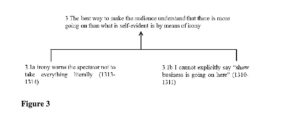 fulfilling a professional duty should be undertaken (maxim from the locus from the final cause), then HS should make the audience understand that show business is going on (final conclusion). Again the locus from the final cause secures the logical validity of the reasoning behind the opposite standpoint (2) (Figure 5).
fulfilling a professional duty should be undertaken (maxim from the locus from the final cause), then HS should make the audience understand that show business is going on (final conclusion). Again the locus from the final cause secures the logical validity of the reasoning behind the opposite standpoint (2) (Figure 5).
If the aim of Tagesschau, as foreseen by its mandate, is to report events in a neutral way, on the basis of evidence and without analyzing them, and making the audience understand something without providing evidence means analyzing events (endoxa), and if HS has no evidence that show business is going on (datum), then making the audience understand that show business is going on means analyzing the event and going against the mandate (first conclusion). The latter becomes the minor premise of a topical syllogism whose major premise is the maxim “if the action X goes against the mandate of an institution Y, X should not be undertaken”. The final conclusion thus is that HS should not make the audience understand that show business is going on.
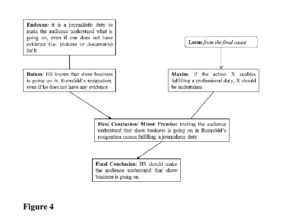 Until now though it has only become clear why standpoints 1 and 2 were eligible for consideration, and they both seem very reasonable. Why the third alternative is selected can be explained by the following reconstruction (Figure 6).
Until now though it has only become clear why standpoints 1 and 2 were eligible for consideration, and they both seem very reasonable. Why the third alternative is selected can be explained by the following reconstruction (Figure 6).
The endoxon at the roots of this reasoning is based on two news values that HS wants to fulfil, and that are valid throughout the journalistic community in Western countries: truthfulness (report what actually happened) and neutrality (do not take stance on events you report about). Furthermore it entails the fact that the three possibilities considered by HS (A, B, C) are alternative. These alternatives involve fulfilling the news values in a different way (datum): saying that show business is going on means being truthful but not neutral (A); not saying that show business is going on means being neutral but not truthful (B); making understand that show business is going on by means of irony allows being truthful and neutral at the same time (C). Therefore only alternative C allows HS to fulfil both news values (first conclusion). Onto this first conclusion the maxim is applied “if an agent wants to fulfil multiple values, and among the alternatives at disposal only X enables him to achieve them all at the same time, X has to be chosen”, derived from the combined loci from alternatives and from end to means. It follows that alternative C should be chosen (final conclusion).
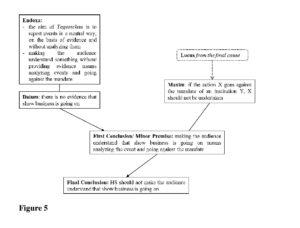 Anyway, it strikes the attentive observer that using irony to convey a message does not really mean embracing neutrality. Instead, it means shifting the responsibility of catching the meaning implied in the ironical expression to the audience, without a clear stance taking on the journalist’s side. Thus HS avoids the risk of being accused of adopting a position towards an event while reporting it – an action that would go against Tagesschau’s mandate – but still can attempt to convey a message he cares for. It remains unclear whether the audience will understand his intention or not.[xx]
Anyway, it strikes the attentive observer that using irony to convey a message does not really mean embracing neutrality. Instead, it means shifting the responsibility of catching the meaning implied in the ironical expression to the audience, without a clear stance taking on the journalist’s side. Thus HS avoids the risk of being accused of adopting a position towards an event while reporting it – an action that would go against Tagesschau’s mandate – but still can attempt to convey a message he cares for. It remains unclear whether the audience will understand his intention or not.[xx]
5. Conclusion
The claim of this contribution was to show that arguing with oneself when making a decision in newswriting is comparable to dialogic argumentation, and that RVPs are data that allow demonstrating it. Proof has been given by analyzing a journalist’s reflections on his writing activity, which includes decisions on how to frame and formulate a news item. In the RVP, HS accounts for his reasoning process for and against each alternative considered. As the reconstruction has shown, while 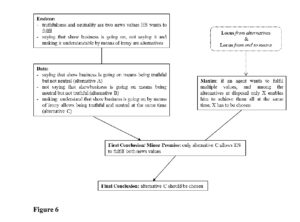 writing he has (or at least believes he has) argued for each possibility within himself, as he would have done with an external interlocutor. His decisions are backed by endoxa and news values, constrained by contextual limitations, professional duties and requirements and regulated by inferential rules in all comparable to those active in an interpersonal critical discussion. In particular, in the present example it became evident how journalists struggle between contrasting forces and need to find concrete solutions to problems that emerge in everyday work, e.g. between the urge to inform the audience about a relevant issue and the neutrality requirement. In HS’ case, irony is the tool adopted to reach a balance between contrasting aspects of the mandate, or at least to convey a message without overtly violating an institutional norm. Argumentative reasoning thus helps the journalist to get through the maze of possible options and find an emergent solution for a given instance of newsmaking.
writing he has (or at least believes he has) argued for each possibility within himself, as he would have done with an external interlocutor. His decisions are backed by endoxa and news values, constrained by contextual limitations, professional duties and requirements and regulated by inferential rules in all comparable to those active in an interpersonal critical discussion. In particular, in the present example it became evident how journalists struggle between contrasting forces and need to find concrete solutions to problems that emerge in everyday work, e.g. between the urge to inform the audience about a relevant issue and the neutrality requirement. In HS’ case, irony is the tool adopted to reach a balance between contrasting aspects of the mandate, or at least to convey a message without overtly violating an institutional norm. Argumentative reasoning thus helps the journalist to get through the maze of possible options and find an emergent solution for a given instance of newsmaking.
Acknowledgements
The author sincerely thanks Rudi Palmieri for his precious advice in the analysis of the RUMS case.
NOTES
i. See also Greco Morasso’s contribution to the present volume. Apart from the investigation of journalistic inner argumentation conducted in the present paper and in Perrin and Zampa (under review), Greco Morasso is – to my knowledge – the only scholar doing corpus-based research on this issue.
ii. This literature review on arguing with oneself is proposed also in Perrin and Zampa (under review).
iii. With Aristotle (Topics I, 100b) I understand endoxa as “[those opinions] which commend themselves to all, or to the majority, or to the wise – that is or to all of the wise or to the majority or to the most famous and distinguished of them”.
iv. The notion of news values is a much-debated one in journalism studies, nevertheless due to space limitations I here only present the definition I adopt.
v. The frame interview is conducted by the researcher at the very beginning of the collaboration with a journalist in order to reconstruct his background and understanding of his role as a newsmaker. The review interview is conducted right after the RVP. In this occasion, the journalist is requested to sum up “what he had to do, wanted to do and actually did when writing the item” (Perrin & Zampa, under review).
vi. sf_ts_061108_2400_HS_rumsfeld_review.doc: 0110-0117 and I wanted that the spectator gets something-/ catches something of the- of the historical moment/ that’s an historical moment now yes/ ehm three four five six it was more than three years of war in iraq/ and ehm now all of a sudden one realizes ehm-/ it is for the first time overtly admitted/ we have made a mistake there/ the man has to go.
vii. sf_ts_061108_2400_HS_rumsfeld_item.doc: 0026-0033 he disempowered saddam hussein/ and helped the iraqi people/ establish a constitutional democracy/ it will go down in history/ that under donald rumsfeld’s leadership/ our troops/ overthrew two terrorist regimes/ and freed about 50 million people.
viii. sf_ts_061108_2400_HS_rumsfeld_item.doc: 0037-0041 I must say/ that it was the highest honor/ that I have experienced in my life/ to have been able to serve with the amazing young men and women/ in uniform.
ix. sf_ts_061108_0000_HS_rumsfeld_verbal_1.doc: 1296-1299 as a journalist now it is something very important for me/ one must always keep at the back of one’s mind in this kind of public appearance/ this now was again pure show business/ a public relations exercise.
x. sf_ts_061108_0000_HS_rumsfeld_verbal_1.doc: 1305-1308 nonetheless as a journalist I have the duty/ to make the spectator somehow perceive/ that I know it that they are doing show business there.
xi. sf_ts_061108_0000_HS_rumsfeld_verbal_1.doc: 1310-1311 of course as a journalist I can’t say/ this was the show business for today.
xii. sf_ts_061108_0000_HS_rumsfeld_verbal_1.doc: 1300-1302 because as a matter of fact he had to throw out rumsfeld/ because he was not supportable anymore/ of course he doesn’t say that.
xiii. A theory based on Systemic Functional Linguistics (Halliday, 1985) that investigates the interpersonal dimension of language use, and devotes considerable attention to journalistic discourse.
xiv. sf_ts_061106_1315_HS_frame_1.doc: 0676-0686 the aim of tagesschau is to show pictures of events/ that have happened/ […]/ the aim cannot be that of analyzing/ the tagesschau doesn’t have the task to analyze/ […]/ the task of analyzing/ and conveying the background/ and to exhaustively represent the connections/ that is the newspapers’ task.
xv. sf_ts_061108_2400_HS_rumsfeld_review_1.doc: 0135-0143 I was requested/ not to make it longer than one minute twenty/ and not to make any background material on rumsfeld/ thus no life of rumsfeld/ quick retrospection that was it then/ the so-called background/ but that I should only show the press conference/ it went like this/ and they said this.
xvi. sf_ts_061108_0000_HS_rumsfeld_verbal_1.doc: 1285-1291 now the question was/ how do I comment on this/ do I simply leave it very dry/ do I say just something/ or do I go into it/ and comment it just as it is/ or do I comment it slightly ironically.
xvii. sf_ts_061108_0000_HS_rumsfeld_verbal_1.doc: 1327-1329 “rumsfeld was visibly moved/ and also president bush somewhat touched/ patted on his commander’s back”.
xviii. sf_ts_061108_0000_HS_rumsfeld_verbal_1.doc: 1312-1314 thus I try to include a bit of irony in it/ that signals the spectator/ well that should not be taken one to one.
xix. sf_ts_061108_0000_HS_rumsfeld_verbal_1.doc: 1335-1342 it would be interesting/ to discuss again about this concluding sentence from a journalistic viewpoint/ to say is it allowed/ is it not allowed/ is it even necessary/ that the journalist shows the spectator/ whoops I know more/ than I can say now.
xx. sf_ts_061108_0000_HS_rumsfeld_verbal_1.doc: 1322-1325 and therefore I try/ to bring in a slightly ironical note in the end/ whether it succeeded/ it is always very difficult to succeed with irony in television.
References
Aristotle. Posterior Analytics. Topica. Tredennick, H. and Fowler H. N. (Eds. and transl.). Cambridge, MA/ London, UK: Harvard University Press.
Bakhtin, M. M. (2006 [1935]). The dialogic imagination: Four essays. Holquist, M. (Ed.). Austin: University of Texas Press.
Billig, M. (1996 [1987]). Arguing and thinking: A rhetorical approach to social psychology. Cambridge: Cambridge University Press.
Dascal, M. (2005). Debating with myself and debating with others. In P. Barrotta & M. Dascal (Eds.), Controversies and Subjectivity (pp. 33-73). Amsterdam/ Philadelphia: John Benjamins.
Eemeren, F. H. van, & Grootendorst, R. 2004. A Systematic Theory of Argumentation. The pragma-dialectical approach. Cambridge: Cambridge University Press.
Gnach, A. (2013). Produktion von Fernsehnachrichten. Unterschiede zwischen der deutsch- und französischsprachigen Schweiz. Wiesbaden: Springer VS.
Greco Morasso, S. (2013). Multivoiced decisions. A study of migrants’ inner dialogue and its connection to social argumentation. Pragmatics & Cognition, 21(1), 55–80.
Halliday, M. (1985). Introduction to functional grammar. London: Edward Arnold.
Martin, J. R., & White, P. R. R. (2005). The Language of Evaluation – Appraisal in English. Basingstoke/ New York: Palgrave Macmillan.
Perelman, C., & Olbrechts-Tyteca, L. (2010 [1958]). The New Rhetoric. A Treatise on Argumentation. Notre Dame (Indiana): University of Notre Dame Press.
Perrin, D. (2003). Progression analysis (PA): investigating writing strategies at the workplace. Journal of Pragmatics, 35(6), 907-921.
Perrin, D., (2013). The linguistics of newswriting. Amsterdam/ New York et al.: John Benjamins.
Perrin, D., & Zampa, M. (Under review). Arguing with Oneself: the Writing Process as an Argumentative Soliloquy. Journal of Argumentation in Context: Argumentation in Journalism.
Pounds, G. (2010). Attitude and subjectivity in Italian and British hard-news reporting: The construction of a culture-specific ‘reporter’ voice, Discourse Studies, 12(1), 106-137.
Rigotti, E. (2005). Congruity theory and argumentation. Studies in Communication Science: Argumentation in Dialogic Interaction, 75–96.
Rigotti, E. (2006). Relevance of Context-bound loci to Topical Potential in the Argumentation Stage, Argumentation, 20, 519-540.
Rigotti, E., & Greco Morasso, S. (2009). Argumentation as an Object of Interest and as a Social and Cultural Resource. In N. Muller Mirza & A.-N. Perret-Clermont (Eds.), Argumentation and Education (pp. 9-66). Dordrecht: Springer.
Rigotti, E (2010). Comparing the Argumentum Model of Topics to Other Contemporary Approaches to Argument Schemes: The Procedural and Material Components. Argumentation, 24(4), 489–512.
Rigotti, E (in preparation). Inference in argumentation: A topics-based approach to argument schemes. To be submitted to the Springer Argumentation Library.
Rocci, A. (2005). Connective predicates in monologic and dialogic argumentation. Studies in Communication Sciences: Argumentation in Dialogic Interaction, 97–118.
Vygotsky, L. (1962 [1934]). Thought and Language. E. Hanfmann & G. Vakar (Eds. and transl.). Cambridge, MA: The MIT Press and New York/ London: Wiley.
You May Also Like
Comments
Leave a Reply
